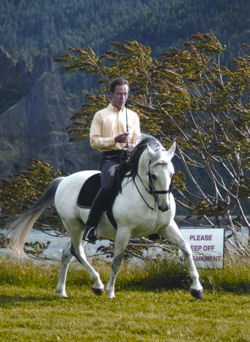The Shoulder In
Shoulder In Defined
The horse is evenly bent around the rider’s inside leg and travels at a 30 degree angle to the track. The hind feet remain on the track and step straight ahead for the most part. The horse’s outside should should be in line with its inside hip (i.e. – three track).
How to Execute the Shoulder In
- Start in Working Trot, sitting or rising
- Prepare the horse by riding an 8- or 10- meter volte coming out of first corner of the long side
- Half halt and place more weight on the inside seat bone
- Place the inside leg next to the girth actively pushing the horse forward and sideways simultaneously
- Place the outside leg behind the girth to prevent the horse’s outside hind leg from swinging out
- The inside rein brings the horse in from the track at the beginning of the exercise and maintains the bend throughout
- The outside rein must maintain flexion but be flexible enough to allow the outside shoulder to step forward
- The rider should look through the horse’s ears to insure that his weight is evenly distributed
NOTE: The initial volte can be removed from this exercise when the horse shows adequate strength and understanding to proceed effectively without tension or confusion. The shoulder in is not a movement that can just be started. The horse must have adequate preparation in order to perform this movement correctly. Prior to working on shoulder in, it is necessary to confirm that the horse has relaxation, suppleness, rhythm and connection. He must also understand moving away from the leg as in the leg yield. Proper preparation will ensure success in performing this movement.
Purpose of the Shoulder In
The shoulder in is the beginning of collection, straightening and hind leg activity. It is fundamental in training because it assists in the development of impulsion and the horse’s ability to be truly “through.”
- To develop lateral bend
- To make the horse straighter
- To build power and expression
- To increase flexion of the haunches
- To improve collection
Common Errors in Execution
- Rider asks for too much from the horse initially – this movement requires time to build up to working the full length of the long side
- The horse’s head and neck are bent too far to the inside
- The horse tilts his head thus preventing a bend through the ribs
- The angle away from the wall is too great
- The rider cannot delineate between the leg yield and the shoulder in
- The horse loses his rhythm and impulsion because the rider does not rider the horse forward enough.
Author: Dressage Academy
Serpentines
Shoulder Fore
You May Also Like

Rejuvenate Your Dressage Horse
July 6, 2017
Rhythm – Let’s Get into the Groove Newsletter
March 28, 2018
One Comment
Pingback: